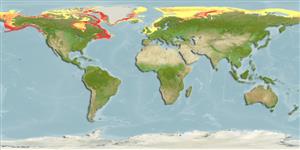Environment: milieu / climate zone / depth range / distribution range
Ecology
Marine; demersal; depth range 0 - 647 m (Ref. 50610), usually 100 - 200 m (Ref. 5951). Polar; 84°N - 43°N, 180°W - 180°E (Ref. 117245)
Arctic, Northwest to Northeast Atlantic, Northeast Pacific: Greenland, Canada, and southeastern Alaska (Ref. 2850).
Size / Weight / Age
Maturity: Lm ? range ? - ? cm
Max length : 52.0 cm TL male/unsexed; (Ref. 2850)
Occurs among seaweeds or rocks (Ref. 7251). Often found in empty scallop shells (Ref. 7251). Benthic species. Feeds on crustaceans (Ref. 58426), such as amphipods and crabs (Ref. 5951).
Life cycle and mating behavior
Maturities | Reproduction | Spawnings | Egg(s) | Fecundities | Larvae
Robins, C.R., R.M. Bailey, C.E. Bond, J.R. Brooker, E.A. Lachner, R.N. Lea and W.B. Scott, 1991. Common and scientific names of fishes from the United States and Canada. Am. Fish. Soc. Spec. Publ. (20):183 p. (Ref. 3814)
IUCN Red List Status (Ref. 130435)
Threat to humans
Harmless
Human uses
Tools
Special reports
Download XML
Internet sources
Estimates based on models
Preferred temperature (Ref.
123201): -1.4 - 5.9, mean -0.3 °C (based on 868 cells).
Phylogenetic diversity index (Ref.
82804): PD
50 = 0.5000 [Uniqueness, from 0.5 = low to 2.0 = high].
Bayesian length-weight: a=0.01148 (0.00483 - 0.02731), b=3.05 (2.84 - 3.26), in cm total length, based on LWR estimates for this (Sub)family-body shape (Ref.
93245).
Trophic level (Ref.
69278): 3.7 ±0.3 se; based on diet studies.
Resilience (Ref.
120179): Medium, minimum population doubling time 1.4 - 4.4 years (Fec=4,000-12,000).
Fishing Vulnerability (Ref.
59153): Moderate vulnerability (41 of 100).
